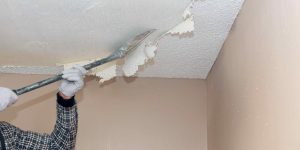
If you live in a home that was built before 1978, then you likely have a popcorn ceiling. While they may be nostalgic, popcorn ceilings can be dangerous to your health and should be removed if possible. Here’s everything you need to know about popcorn ceilings: what they are, why they’re bad for your health, and who can remove them. Popcorn Ceiling Removal Near Lakewood CO
What Is a Popcorn Ceiling?
A popcorn ceiling is a textured surface made of plaster-like material that looks like the kernels of popped corn. The material was popular in the 1960s and 1970s, but many homeowners today don’t like how it looks after years of wear and tear. If you want to remove a popcorn ceiling, you’ll need to hire a contractor who specializes in this type of project–and even then, there are no guarantees that they’ll be able to get rid of all traces of it!
The material itself consists primarily of plaster (usually gypsum), glue (typically casein or polyvinyl acetate), sand, and water–the ingredients for traditional drywall mixes as well–but instead being applied by hand or machine over wooden lath boards installed horizontally across walls at regular intervals, it gets sprayed onto ceilings from above using a special spray gun connected directly into pipes running through ductwork located behind walls below ceilings themselves.
The Dangers of Popcorn Ceilings
As you may have guessed, the process of creating popcorn ceilings was far from safe. The original recipe for this textured ceiling involved using asbestos fibers as well as lead paint–both of which are known to cause serious health problems in humans. Asbestos is a carcinogen that can lead to lung cancer and mesothelioma (a rare form of cancer that affects the lungs, chest, or abdomen). Lead poisoning can cause irreversible brain damage in children under age six who ingest it through their mouths or skin contact; adults with high levels of lead in their blood often experience heart disease, hypertension, and kidney failure later on down the road too!
But there’s more: mold loves damp places like bathrooms where moisture seeps through walls easily thanks to poor ventilation systems; this means if your bathroom has a popcorn ceiling then it’s likely covered with mold spores too! And finally, there’s humidity–which if present at high levels can cause structural damage such as cracking plasterboard walls due to excessive moisture absorption.
One of the biggest issues with popcorn ceilings is mold and mildew. It’s no secret that these unsightly growths can grow on just about any surface, but they’re especially common in areas with high moisture levels such as bathrooms, kitchens, and basements. Hire a contractor today to remove popcorn ceilings!
How to Identify Asbestos
Asbestos is a fibrous mineral that can be found in many types of building materials, including insulation and ceiling tiles. Asbestos fibers are linked to lung cancer and other health problems when they’re inhaled over a long period. It’s important to know how to identify asbestos so you can avoid these risks when working with it or removing it from your home.
There are several ways to identify asbestos:
- Look for telltale signs like crumbling walls or damaged floor tiles. These can indicate that there may be more extensive damage underneath the surface (like cracks in the plaster). If you see any signs like this, contact an expert immediately!
- Use an instrument called an X-ray fluorescence analyzer (XRF). This tool uses ultraviolet light and reflected X-rays from samples taken from different areas within your home; it will reveal whether any materials contain asbestos fibers based on their chemical composition.
When to Remove a Popcorn Ceiling?
When you’re ready to remove a popcorn ceiling, there are a few factors you should consider. For example, if the ceiling is damaged or peeling and needs replacement, it might be worth hiring a professional contractor to do the job right. Otherwise, if you’re planning on remodeling shortly and want your new space to look different from what’s already up there–or if you’re selling your home and want potential buyers to see what they’d be getting themselves into–a DIY approach might work best for you.
Who Can Remove My Popcorn Ceilings?
You should hire a professional contractor to remove your popcorn ceiling. A professional will have the experience and tools needed to do the job right, and they’ll be able to do it quickly and efficiently. They can also help you determine whether or not asbestos is present in your home’s insulation, which is important if you want to avoid potential health risks associated with exposure.
If you decide not to hire someone else, make sure that you’re careful while removing any loose pieces of material from above your head! It may seem like fun at first (until someone gets hurt), but it’s better just not to mess around with something like this unless necessary–or at least until after calling in professional contractors who know how much pressure can safely be applied before cracking plasterboard walls or ceilings.
Popcorn Ceiling Removal Near Lakewood CO
The bottom line is that popcorn ceilings can be dangerous. They can cause mold and mildew, they’re a potential source of asbestos and other harmful chemicals, and they don’t do anything to help keep your home warm in winter or cool in summer. If you have one of these ceilings in your house, it’s time to remove them! If you have further questions contact us at Home Drywall and Painting in Lakewood, Colorado today!
